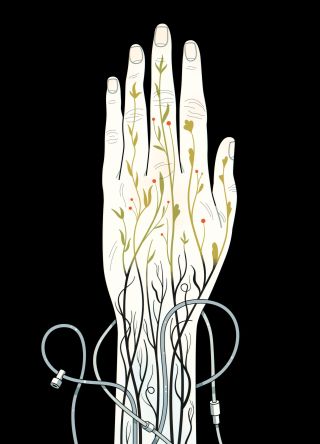A disturbing report from the front lines of the war on cancer.

We have cancer therapies, Vincent DeVita says, that could cure another hundred thousand patients if used to their full potential.
CREDIT ILLUSTRATION BY HARRY CAMPBELL
In the fall of 1963, not long after Vincent T. DeVita, Jr., joined the National Cancer Institute as a clinical associate, he and his wife were invited to a co-worker’s party. At the door, one of the institute’s most brilliant researchers, Emil Freireich, presented them with overflowing Martinis. The head of the medical branch, Tom Frei, strode across the room with a lab technician flung over his shoulder, legs kicking and her skirt over her head. DeVita, shocked, tried to hide in a corner. But some time later the N.C.I.’s clinical director, Nathaniel Berlin, frantically waved him over. Freireich, six feet four and built like a lineman, had passed out in the bathtub. Berlin needed help moving him. “Together, we pulled him up, threw his arms over our shoulders, and dragged him out through the party,” DeVita writes, in his memoir, “The Death of Cancer” (Sarah Crichton Books). “Out front, Freireich’s wife, Deanie, sat behind the wheel of their car. We tossed Freireich in the backseat and slammed the door.”
Half a century ago, the N.C.I. was a very different place. It was dingy and underfunded—a fraction of its current size—and home to a raw and unruly medical staff. The orthodoxy of the time was that cancer was a death sentence: the tumor could be treated with surgery or radiation, in order to buy some time, and the patient’s inevitable decline could be eased through medicine, and that was it. At the N.C.I., however, an insurgent group led by Frei and Freireich believed that if cancer drugs were used in extremely large doses, and in multiple combinations and repeated cycles, the cancer could be beaten. “I wasn’t sure if these scientists were maniacs or geniuses,” DeVita writes. But, as he worked with Freireich on the N.C.I.’s childhood-leukemia ward—and saw the fruits of the first experiments using combination chemotherapy—he became a convert. Continue reading →
 By now, you probably have come to realize that something is not quite right with the current health care system that dominates today. It has become a dictating, disease managing, and complicated mess that has generally left more people sick than healthy. Sure, it’s great for emergency and acute care, but when it comes to eradicating disease, it hasn’t even sniffed the coffee yet.
By now, you probably have come to realize that something is not quite right with the current health care system that dominates today. It has become a dictating, disease managing, and complicated mess that has generally left more people sick than healthy. Sure, it’s great for emergency and acute care, but when it comes to eradicating disease, it hasn’t even sniffed the coffee yet.


 It leaves people bed-bound and drives some to suicide, but there’s little research money devoted to the disease. Now, change is coming, thanks to the patients themselves.
It leaves people bed-bound and drives some to suicide, but there’s little research money devoted to the disease. Now, change is coming, thanks to the patients themselves.  Today, I am grateful to have a better understanding of the relationship between cholesterol and health. How about you? Are you afraid of having high cholesterol? Are you throwing away egg yolks because you think they’re bad for your health? Are you taking cholesterol-lowering medication or considering starting on one?
Today, I am grateful to have a better understanding of the relationship between cholesterol and health. How about you? Are you afraid of having high cholesterol? Are you throwing away egg yolks because you think they’re bad for your health? Are you taking cholesterol-lowering medication or considering starting on one?  A gang of 14 state attorneys general, led by New York Attorney General Eric Schneiderman and Indiana Attorney General Greg Zoeller, has threatened to file a class action lawsuit against the dietary supplement industry for supposedly selling herbal products that don’t contain the listed ingredients.
A gang of 14 state attorneys general, led by New York Attorney General Eric Schneiderman and Indiana Attorney General Greg Zoeller, has threatened to file a class action lawsuit against the dietary supplement industry for supposedly selling herbal products that don’t contain the listed ingredients. A pharmaceutical drug developed by the United States Army as a supposed treatment and preventive agent for malaria is instead proving to be an ineffective, deadly, psychotropic poison. The drug, known as mefloquine (or Lariam under its brand name), is reportedly causing British soldiers to develop severe depression and mental illness, and some political leaders are now calling for its removal from the official military drugging schedule.
A pharmaceutical drug developed by the United States Army as a supposed treatment and preventive agent for malaria is instead proving to be an ineffective, deadly, psychotropic poison. The drug, known as mefloquine (or Lariam under its brand name), is reportedly causing British soldiers to develop severe depression and mental illness, and some political leaders are now calling for its removal from the official military drugging schedule.  Independent researchers couldn’t reproduce the findings of more than half of 100 experiments previously published in three prominent psychology journals, a new review reports.
Independent researchers couldn’t reproduce the findings of more than half of 100 experiments previously published in three prominent psychology journals, a new review reports. Below is a clip taken from the “One More Girl” documentary, a film regarding the Gardasil vaccine, which was designed to prevent Human Papillomavirus. In it, Dr. Peter Rost, MD, a former vice president of one of the largest pharmaceutical companies in the world (Pfizer), shares the truth about the ties between the medical and pharmaceutical industry.
Below is a clip taken from the “One More Girl” documentary, a film regarding the Gardasil vaccine, which was designed to prevent Human Papillomavirus. In it, Dr. Peter Rost, MD, a former vice president of one of the largest pharmaceutical companies in the world (Pfizer), shares the truth about the ties between the medical and pharmaceutical industry.  In response to a recent International Agency for Research on Cancer report, which found that the Monsanto herbicide glyphosate “probably” causes cancer in humans, a cohort of international doctors is now petitioning the European Union Parliament, the EU Commission, and several other health and food safety authorities to take action by banning the use of this prolific chemical.
In response to a recent International Agency for Research on Cancer report, which found that the Monsanto herbicide glyphosate “probably” causes cancer in humans, a cohort of international doctors is now petitioning the European Union Parliament, the EU Commission, and several other health and food safety authorities to take action by banning the use of this prolific chemical.  A federal judge also found that lawmakers intended to permit the GMO ban when they excluded Jackson County from a 2013 bill that pre-empted other local governments from regulating biotech crops.
A federal judge also found that lawmakers intended to permit the GMO ban when they excluded Jackson County from a 2013 bill that pre-empted other local governments from regulating biotech crops. What happens when one courageous attorney and a few citizens try to take down Monsanto? The MSM doesn’t cover it, for starters.
What happens when one courageous attorney and a few citizens try to take down Monsanto? The MSM doesn’t cover it, for starters.